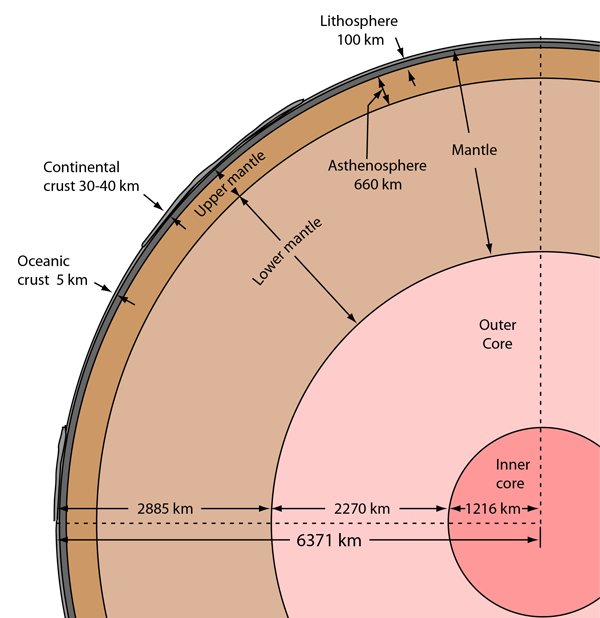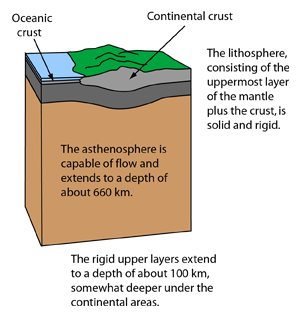Structure of the Earth
The illustration below is an attempt to model the large scale internal structure of the Earth based on data from Lutgens & Tarbuck. The habitable part of the Earth is a very thin layer. Though one might quibble with the precision, the following captures the perspective "all life is confined to the space between the snow of the mountain tops and the heat of the Earth's interior. This narrow stratum as compared with the diameter of the Earth is but one half the thickness of one leaf of a thousand-page book." (Morrison)

 | The uppermost layer of the mantle and the crust tend to act together as a rigid shell. Together they are called the lithosphere, the "sphere of rock". The lower level of the mantle is called the asthenosphere and it is softer and weaker, particularly in its upper portion where a small amount of melting can occur. It is at this level where the model of plate tectonics suggests that horizontal movement can occur as a result of convection of heat upward from the Earth's core. |
The continental crust is made up of lighter granitic rock, while deep-sea drilling reveals that the oceanic crust is basaltic in composition. Basalt is significantly more dense (about 3 gm/cm3) than granite (about 2.6 gm/cm3). The asthenosphere is thought to be a more dense rock like peridotite. This judgement comes from the fact that lava reaching the surface in volcanic activity comes from the melting of the upper asthenosphere. Lava of similar composition can be obtained by melting peridotite.
Modeling the core of the Earth must rest upon even more indirect evidence. We observe that the metallic meteorites have cores of iron and nickel, and this correlates with other evidence that suggests that the Earth's core is similarly composed of iron and nickel. Modeling the density of the center of the Earth yields densities of about 14 times that of water, which could be obtainable by compressing iron and nickel, but not surface type rocks. An iron core also gives us a circulating electrical conductor, which could provide the necessary mechanism for creating the Earth's magnetic field.
The following table of density and depth data was taken from a USGS publication by Eugene C. Roberson entitled The Interior of the Earth. (http://pubs.usgs.gov/gip/interior/)
| Types of rock found | ||||
| Crust | Silicic rocks | |||
| Andesite, basalt at base | ||||
| Upper mantle | Peridotite, eclogite, olivine, spinel, garnet, pyroxene | |||
| Perovskite, oxides | ||||
| Lower mantle | Magnesium and silicon oxides | |||
| Outer core | Iron + oxygen, sulfur, nickel alloy | |||
| Inner core | Iron + oxygen, sulfur, nickel alloy | |||
| Total thickness | ||||
Geophysics concepts
References:
Lutgens & Tarbuck
Ch 15
Morrison
| HyperPhysics | R Nave |